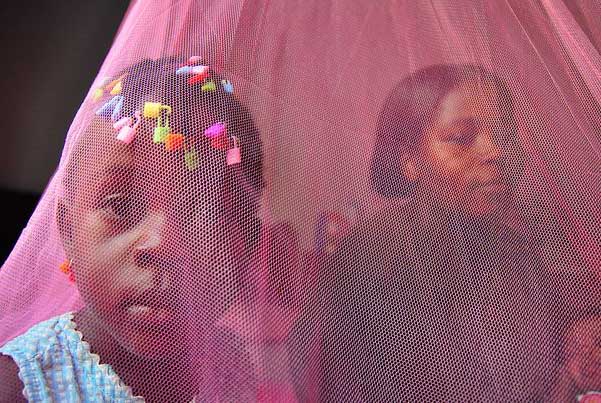Malaria in Pregnancy
Malaria is a major threat to the life of a mother and her unborn child. The impact of the disease will depend on the strength of the mother‚ her immune system and the severity of the Malaria.
However the fact remains that malaria during pregnancy reduces birth weight, and low birth weight is a major cause of infant mortality.
In the mother, malaria can have complications that include anemia, fever, hypoglycemia, bleeding, post natal infections, pulmonary edema, cerebral malaria and death.
For the unborn child an infection of Malaria can result in abortion, still birth, congenital infection or anemia. Maternal anemia and malaria infections in the second trimester reduce weight gain in the unborn child and can cause the fetus to grow more slowly resulting in low birth weight, and increasing the chances of infant mortality.
It has also been shown that if malaria is present in the placenta that maternal antibodies are not efficiently exchanged with the growing child and thus the childs immunity is weakened.


Placental Infection
When the mosquito bites its victim it injects the parasites that cause Malaria into the blood stream. These parasites initially travel to the liver and penetrate the liver cells where they are incubated for a time. After incubation they explode into the blood stream and invade red blood cells where they multiply.
The red blood cells become filled with the new parasites and burst to release them to attack other red blood cells. At the same time they also release poisons produced from the destruction of red blood cells, this causes fever and it is at this time that the symptoms of Malaria are first experienced as the body tries to grapple with the presence of the parasitesnin the blood.
After 36 to 72 hours (depending on the type of Malaria) the red blood cell is destroyed and parasites in greater numbers re-enter the blood stream and attack more red blood cells. The destruction of large numbers of red blood cells is a major cause of anemia.
Once falciparum parasites enter the red blood cell they cause the outside of the cell to become sticky and the cell becomes less flexible. This causes the red blood cells to adhere to the lining of the capillaries in major organs such as the brain, liver and in the pregnant mother, the placenta.
With placental malaria, large numbers of red blood cells containing parasites lodge in the microcirculation of the placenta which is rich in capillaries, and because of its relative isolation from the rest of the circulatory system, it is an ideal place for malaria parasites to multiply. Thus large numbers of new parasites are produced in the placenta. These are eventually released and attack more red blood cells putting both the mother and child at great risk.
The blocking of the capillaries in the placenta congests the microcirculation resulting in hypoxia and blockage of nutrients to the unborn child. This can cause, abortion, still birth, early labor, reduction of weight gain in the child or slow the development of the growing fetus. The child can also be infected with malaria.
“Placental malaria complicates the way that the malaria is treated”
Limited Immunity
Research has shown that limited immunity to malaria can develop if the mother has had the same strain of malaria more than once and the body has been able to develop limited resistance to the infection. Immunity to malaria can be short lived and in stable transmission areas may only last a few months. However, whilst there are 4 types of malaria there are hundreds of strains. Researchers believe that limited immunity has a better chance of developing where only a single strain of malaria lives within the local area. Should different strains of malaria be introduced through the presence of carriers from other regions then the limited immunity will not be of benefit to the victim. Even though a patient may have limited immunity and the impact of the infection is less severe; it does not decrease the danger to the fetus as the parasites are still the present in the placenta.
A second issue with regards to limited immunity in pregnancy is that the limited immunity in a pregnant woman is less than in other victims of the disease. This is due to the suppression of the immune system that happens in a womans body during pregnancy.
Placental malaria complicates the way that the disease is treated. If an infected pregnant mother is treated for Malaria sometimes tests will show that the antimalarial medications administered have successfully treated the disease. However this may not be the case. Case studies show that the malaria parasites sequestered (hidden) in the placenta may be unaffected by antimalarial medication; and that in actual fact, despite blood tests showing the peripheral circulation to be parasite free, the parasites have freely multiplied in the placenta to alarming levels, leaving both mother and child at serious risk.
The presence of the parasites in the placenta leads to patient re-infection, therefore the treated mother will need to be re-tested for malaria regularly after the initial treatment has ceased. In the pregnant woman, treatment may also need to be for longer periods of time. Antenatal clinics often treat mothers in the malaria endemic areas with antimalarials at their antenatal visits as prevention against malaria taking hold.
Pregnancy also limits the antimalarials that can be used to treat the disease as some of the chemicals used are dangerous to the mother’s health and to the viability of the fetus. Health care workers should check contraindications of antimalarial medications before using them to treat pregnant women.
